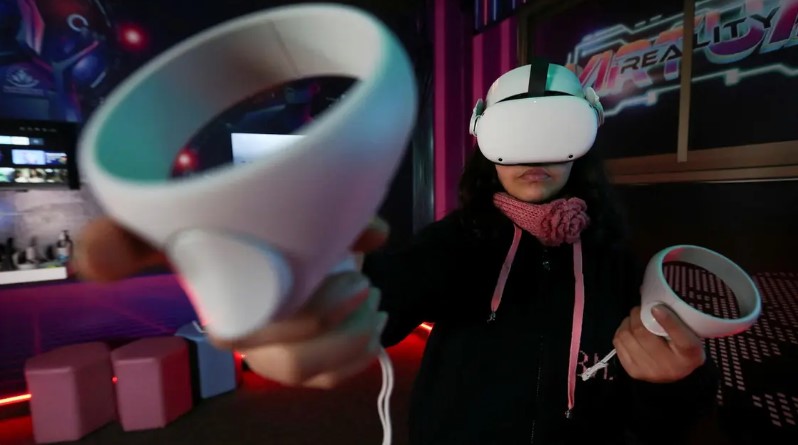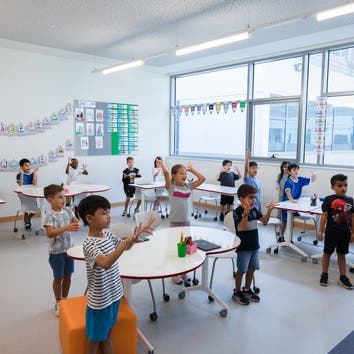How innovative technologies such as VR helping accelerate learning in the classroom
Flying through space in search of planets that can sustain life. Travelling back in time to World War II. Scaling an active volcano to watch how it erupts. These may sound like sci-fi movie plots, but instead, they’re virtual reality (VR) activities schools are implementing to enhance learning.
Some may argue that using these technologies increases screen time and inhibits children playing and interacting with the real world. Others may say that they foster solitary learning and individual behaviours. But we have found that, when done right, utilising these technologies will be a game changer in their education. Every change or enhancement does involve some element of risk. Therefore, we must guide and support children to make healthy decisions and use technology to benefit learning and community building, not the opposite.
VR environments take users beyond the flat screen and simulate spaces where you can interact with virtual surroundings in 3D. When students put on a VR headset and grab their motion controllers, they can explore any place imaginable and feel like they’re there.
As an Augmented Reality (AR)& VR Lead at a global online school, I may be biased in saying this has been a revolutionary educational development. Still, I’ve had the unique privilege of seeing the incredible benefits these technologies have to offer first-hand. As an educator, VR in education isn’t just about engagement. It’s about enhancing the learning experience beyond what’s ordinarily possible.
Research over the years (including my own pilot study) shows that VR can help students focus, improve their understanding of complex topics, boost their ability to recall information when tested, and much more. It is fully immersive and can connect with students of all learning styles, from visual to auditory to physical. The benefits of VR are unmatched, and today’s students have much to gain from learning with this technology.
For example, reading about life during Nazi rule through Anne Frank’s diary is one thing; putting yourself in her shoes is another. With their VR apparatus, students can be transported back in time to explore a complete recreation of Anne’s annex without leaving their desks.
“I don’t usually feel moved by books or texts,” one of my students told me after visiting an Anne Frank VR tour, “but actually experiencing what it was like… feels almost haunting.”
Virtual reality experiences like these are more than just emotive — they’re also effective. Even with no prior teaching on the subject, our students could explain the facts of Anne’s time based on the 25-minute VR tour alone. Combined with traditional teaching approaches, this kind of learning can take knowledge and understanding to a new level.
The applications of VR are endless, with gains seen across various subjects and skill sets. For example, focusing in class is a common difficulty, but virtual reality gets students to actively engage throughout a whole lesson by immersing them in the topic at hand. VR also opens access to opportunities that many would be unable to experience otherwise. Not many will get to go scuba diving or visit the Great Wall of China in real life. With VR, anyone can explore marine ecosystems or walk the wall’s length, regardless of budget or physical mobility.
Technology such as VR can have tangible benefits at virtually every level of learning. At the school I work with, our International Baccalaureate students regularly don VR headsets to complement their live classes and other interactive learning tools. Inquiry is one of the key aspects of International Baccalaureate learning, and immersive education is an incredible way to drive that curiosity and investigation. For younger students, we’ve got VR playgrounds which we’re using to connect groups of schools worldwide to bring students together.
While getting fellow educators familiar enough with the tools to start creating learning experiences for themselves is a challenge, there’s an art to using the technology, and it does take time to master. But once you put a headset on a teacher, it can dramatically change their perspective. In my experience working with teachers on VR applications, they always come away with new ideas for delivering lessons. A colleague of mine (a law and politics teacher) was pleased to learn they could stage debates in parliament and court through a virtual reality environment.
Once the environment is in front of you, you can see the scale, hear it, and feel it. The experience quickly becomes a source of profound inspiration.
VR is one of many innovative learning methods I hope to see more young people gain access to in the future. One day, VR may be as commonplace in schools as pens and paper or computers. As a teacher at a school already implementing this technology, I believe we’re giving our students a head start towards the future of education.


